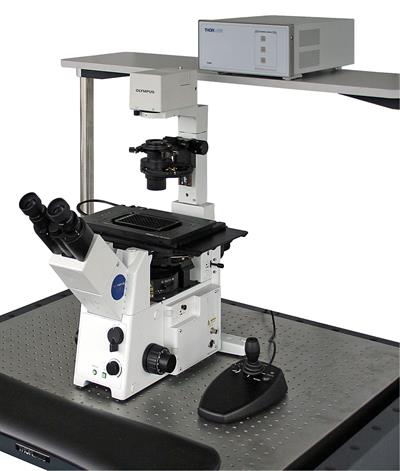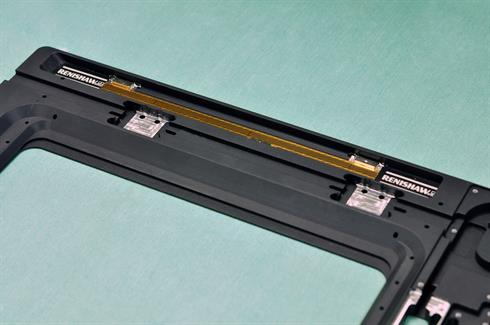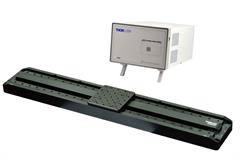Thorlabs designs and manufactures a wide array of photonics equipment including motion control, imaging, light analysis, optoelectronics and optomechanics for the research, industrial, life science, medical, and defence segments. Founded in 1989 and headquartered in New Jersey, USA, the business employs over 1500 people worldwide that support a 15,000 strong product portfolio. Thorlabs customers range from academic researchers to major OEM accounts.
Thorlabs subjected Renishaw’s TONiC encoders to a battery of tests in direct competition with other optical encoder brands. The TONiC series outperformed the competition in every test and was selected to equip both the Thorlabs DDS600 600 mm long travel stage and the MLS203 microscope stage. Mark Robson, Engineering Manager at Thorlabs Ltd, UK, emphasises: “Renishaw’s TONiC series of encoders have enabled Thorlabs to deliver high-performance motion control products that our customers can depend upon. We evaluated TONiC, with respect to strict criteria, alongside other leading brands and found its performance to be best-in-class.”
Higher performance
Measuring 800 mm (L) x 130 mm (W) x 50 mm (H), the DDS600 stage comprises a platform mounted onto a linear axis and driven by a linear DC synchronous motor. Linear motors eliminate the need for mechanical couplings, allow backlash-free operation of the motion stage and enable highly repetitive operations that would otherwise cause wear in a traditional motorized lead-screw. Thorlabs required a high quality velocity feedback solution to commutate the linear motor and meet the demanding metrology requirements of a high accuracy scientific motion stage. A compact high-performance encoder readhead was also specified in order to allow integration with low profile motion stages without sacrificing stage rigidity – as is common when removing material to accommodate larger package sizes.
Thorlabs carried out a failure mode analysis on the DDS600 design that highlighted the encoder signal cable as one of a few theoretical potential points of failure. Renishaw technical support shared data that provided information on cable lifetime expectations, which were subsequently evaluated independently by Thorlabs under soak test conditions to verify the failure mode assessment. These test results showed that Renishaw’s hi-flex encoder cables perform between 60% – 80% above the specified lifetime, giving Thorlabs the confidence to accurately predict product service life.

Designed for drop-in replacement for the manual stages found on select microscopes, the MLS203 X-Y scanning stages provide motorized X-Y positioning of microscopy samples

RGSZ self-adhesive tape scale was chosen by Thorlabs because it significantly reduces thermal errors and satisfies other performance criteria.
Impressive DDS600 stage performance made possible by Renishaw’s TONiC encoder system includes: minimum 100 nm step-size, ±0.25 μm bi-directional repeatability and a maximum speed of 0.4 m/s.
The dirt immunity performance of a number of competing encoder products was evaluated by the application of isopropyl alcohol (IPA), as a liquid contaminant, and common salt, in place of debris, to the encoder scales. Testing showed that Renishaw’s TONiC encoder system outperformed competing encoder products. This qualitative result allowed Thorlabs to determine that the TONiC encoder would not be susceptible to performance degradation as a result of foreseeable contamination.

The DDS600 stage has a light aluminium construction to minimise the inertia of moving parts to increase load bearing capacity.
The premier encoder solution for compact stages
Key features of TONiC that enhance low profile / compact motion stage performance, in this case, include:
-
Cyclic error of typically ±30 nm offers ‘fine pitch’ encoder performance, allowing improved stage scanning performance with smoother velocity control and increased positional stability.
-
Compact encoder dimensions, 10 mm x 35 mm x 13.5 mm (H x L x W), permit integration with low-profile stages without loss of stage rigidity.
-
Excellent signal stability, supported by advanced filtering optics, in conditions unsuitable for most open optical encoders help minimise maintenance costs.
-
Outstanding encoder performance, with a maximum speed of 10 m/s, and low readhead mass of 10 g enables the development of faster low-inertia motion stages.
-
Long-life, robust, high-flex UL approved readhead cable in lengths up to 10 m, for connection between the readhead and interface, allows tight bend radii and optimisation of the cable track configuration.
-
Robust substrate-mastered scale minimises errors associated with changes to the local thermal environment – contributing to the accuracy and reliability of experimental results.

